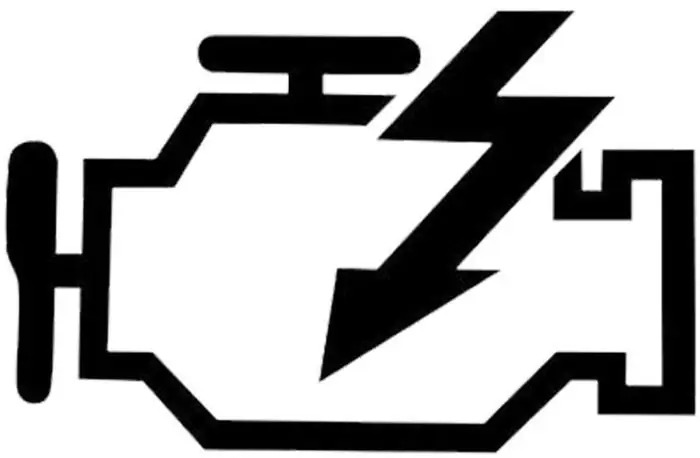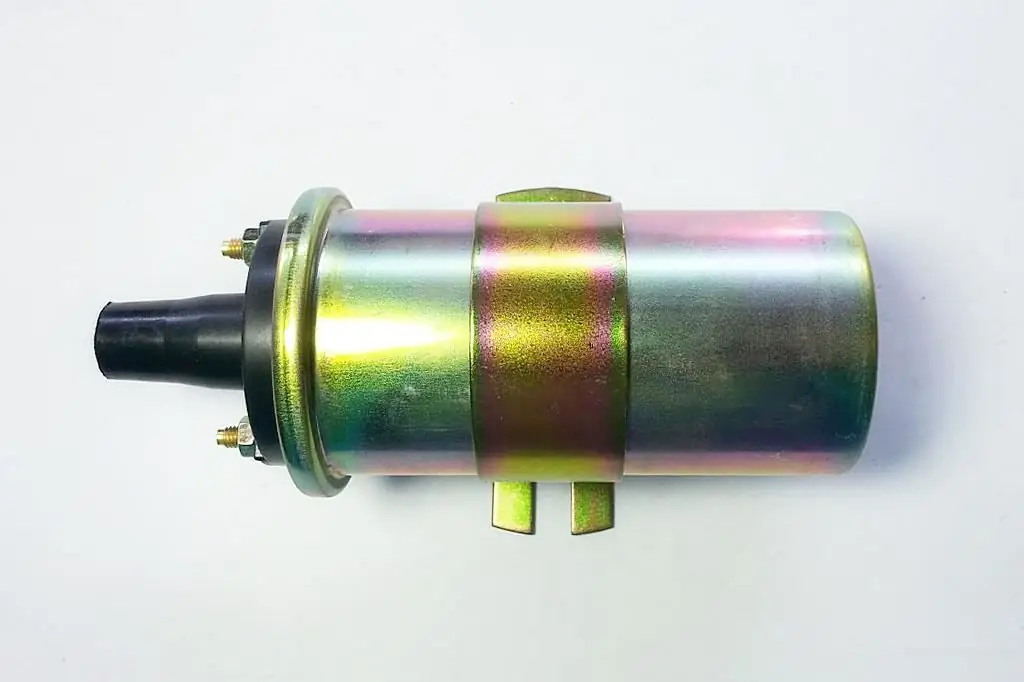2026 Author: Erin Ralphs | [email protected]. Last modified: 2025-01-22 21:14:11
In modern cars, the operation of the engine is controlled by an electronic unit that receives information about the state of he alth of its systems using appropriate sensors. The cooling system, designed to ensure the optimal temperature regime of the motor, includes several such signaling devices. One of them is the coolant temperature sensor (DTOZH). What is this device and what are its functions, we will tell in this article. In addition, we will consider possible malfunctions of this element of the cooling system, as well as ways to diagnose and eliminate them.

DTOZH: what is this sensor and why is it needed?
The coolant temperature sensor is designed to obtain information about the temperature of antifreeze or antifreeze in the system and its subsequent transmission to the electronic control unit. Based on this data, the vehicle controller regulates:
- idling speed when the engine warms up;
- fuel concentration in the combustible mixture;
- Turn the radiator fan on and off.
The principle of the sensor is quite simple. It is based on the properties of semiconductors to change their electric altemperature resistance.
What is a temperature sensor? DTOZH consists of the following elements:
- body (cylinder);
- semiconductor thermistor (resistor that changes resistance with temperature);
- conductive spring;
- electric connector.

How does DTOZH work?
The coolant temperature sensor has two electrical contacts, one of which is a housing that closes to ground, and the second is a “+” going to the electronic unit. The controller sends a voltage of 5 V to the DTOZH, which is transmitted to the working element using a conductive spring. The semiconductor thermistor itself has a negative temperature coefficient, and when the coolant in which it is placed is heated, its resistance begins to decrease. This also reduces stress. It is by changing it that the electronic control unit calculates the temperature of the coolant in the system.
The temperature sensor, due to its simple design, fails quite rarely, but if it happens, it is replaced with a new device. It is not difficult to determine the malfunction of the sensor. Its failure is most often accompanied by certain symptoms that are inherent only to a non-working DTOZH. What are these signs, read on.
Symptoms of non-working DTOZH
You can identify a malfunction of the coolant temperature sensor by the following symptoms:
- the appearance of an error message in the operation of the engine on the dashboardpanel;
- difficulty starting a cold engine;
- high idle engine speed;
- increased fuel consumption;
- Engine overheating due to failed radiator fan.

The last malfunction can be caused not only by DTOZH. If the cooling radiator fan does not work, first of all, check its electric drive and the integrity of the wiring. Only after making sure that they are working, we can conclude that it is the temperature sensor that is to blame for the engine overheating. In this case, DTOZH may turn out to be both non-working and conditionally working.
DTOZH: malfunctions
Coolant temperature sensor malfunctions include:
- violation of the calibration of the working element (thermistor), as a result of which its resistance does not correspond to the prescribed temperature parameters;
- short positive contact to ground;
- violation of the tightness of the sensor housing;
- lack of electrical contact on the connector.
As you can see, there are not so many malfunctions in DTOZH. In the first case, the sensor simply starts to lie, misleading the electronic unit. The latter, using false information, will be forced to make wrong decisions. Hence the difficult start of the engine, and excessive fuel consumption, and untimely switching on of the radiator fan.

A short circuit in the sensor occurs when its body is deformed or destroyed. itthe phenomenon is easily determined by the controller, about which it sends an appropriate signal to the instrument panel.
Breach of the tightness of the housing most often also occurs due to mechanical damage to the sensor, less often due to long-term operation.
If there is no contact on the DTOZH connectors, the controller usually keeps the engine running in emergency mode, and the radiator fan runs continuously just in case.
The first three faults cannot be repaired. Here, only the replacement of DTOZH can correct the situation. In the latter case, contact can be restored, which is not difficult. After that, be sure to double-check the performance of the cooling system.
Where in the car to look for DTOZH?
You can make sure that the sensor is malfunctioning or working by simply checking it. But first you need to know something about the location of DTOZH. Where is the coolant temperature sensor located in a particular car, it is better to find out from its instruction manual. The fact is that in different models it can have a different location. Most often, DTOZH is installed on the inlet pipe of the cylinder head cooling jacket or on the thermostat housing.

It is important not to confuse the coolant temperature sensor with the coolant temperature gauge (CUT). The latter also serves to determine the coolant temperature, however, its data is used solely to inform the driver.
Sensor removal
Checking DTOZH involves dismantling the sensor. ForTo do this, disconnect the negative terminal from the battery and partially drain the coolant. After that, the connector on the DTOZH housing is disconnected. The sensor itself is unscrewed from the seat using an open-end wrench. During the test, the technological opening is closed with a clean rag to prevent moisture or debris from entering the cooling system.
How to check DTOZH?
To check the sensor you will need:
- car tester (multimeter);
- electric kettle or other devices for heating water;
- liquid thermometer.

Checking the sensor is to determine the correctness of the calibration of the working element DTOZH. What does it mean? This means that when conducting a test, it is necessary to establish how correctly the resistance of the thermistor changes depending on temperature.
To begin with, the sensor contacts are connected to the multimeter probes, observing the polarity. The device is switched on in ohmmeter mode. After that, DTOZH together with a thermometer is lowered into cold water and their readings are read. Next, the water is heated, continuing to take measurements.
Below is a table for calibrating coolant temperature sensors.
| Temperature, 0C | Resistance of the working element, Ohm |
| 0 | 7300-7500 |
| +20 | 2600-2800 |
| +40 | 1000-1200 |
| +60 | 500-600 |
| +80 | 300-350 |
| +100 | 160-180 |
If the resistance values of the DTOZH working element differ from those given in the table, the sensor is faulty.
How to replace?
The process of replacing the sensor will not cause any difficulties even for a person who has never repaired a car, especially if the device has already been dismantled for verification. The only thing to do is to purchase a new DTOZH. The price of coolant temperature sensors, depending on the brand of the car, can vary between 300-800 rubles.

Having bought DTOZH, all you need to do is to first check it in the way described above (for greater confidence in its performance), and then screw it into place of the old one and connect the appropriate connector. After that, add coolant, and also connect the ground wire to the battery. Next, we start the engine, warm it up and observe the operation of the cooling system: does the error on the dashboard disappear, does the radiator fan turn on in a timely manner, does the engine run evenly, etc.
Helpful tips
- Before you start replacing a non-working coolant temperature sensor, make sure that it is the cause.
- Buy and install DTOZH only of the modification provided by the car manufacturer.
- Regularly check the condition of the cooling system and the performance of its individual elements.
- Pay attention to the temperature of the coolant. If an error occurs on the instrument panel related to the he alth of the cooling system, immediately take measures to eliminate the causes of the malfunction.
- Never fill the engine with poor quality coolant or water. Do not mix antifreeze and antifreeze in the same system.
Recommended:
Flashing "check" and troit engine: diagnostics, search for causes and repair

The car is a complex of complex components and mechanisms. No matter how automakers improve production technology and increase reliability, no one is immune from sudden breakdowns. This applies to all car enthusiasts. Both the owner of an expensive foreign car and a supported VAZ may encounter such a malfunction as engine tripping. Well, let's consider why the "check" is flashing on the car and the engine is troit
Why is the Check Engine light on? Why does the check engine light come on?

In the age of modern technology, the technical characteristics of a car provide for the presence of a large number of electronics. Cars are literally stuffed with it. Some motorists do not even understand why it is needed or why this or that light is on. In our article we will talk about a small red light bulb called Check Engine. What is it and why does the "Check" light up, let's take a closer look
Starter solenoid relay: how to check and repair

The article describes in detail and clearly the purpose, device and principle of operation of the starter solenoid relay. Typical malfunctions and methods of verification are indicated. Detailed procedure for removal and repair
How to check the ignition coil for serviceability?

What is an ignition coil, its purpose and design. Typical malfunctions of the ignition coil and their causes. Varieties and details on how to check the ignition coil yourself, with a multimeter
How to check high voltage wires on a car?

Most vehicles use high voltage wires to carry electrical current from the ignition coil or module to the spark plugs. Just like other parts of the car, they can fail during operation. Electrical and electromagnetic interference occurs as a result of a discrepancy between the quality of the car wire and the established parameters

